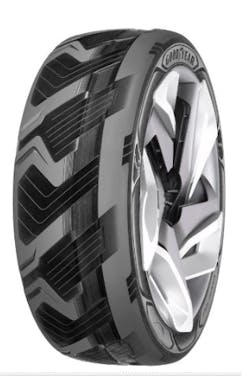At the recent Geneva International Motor Show the Goodyear Tire & Rubber Company unveiled a radical new tire. Named “BHO3,” it offers the possibility of charging the batteries of electric cars by transforming the heat generated by the rolling tire into electrical energy. “These concept tires reimagine the role that tires may play in the future,” said Joe Zekoski, Goodyear’s senior vice president and chief technical officer. “We envision a future in which our products become more integrated with the vehicle and the consumer, more environmentally friendly and more versatile.”
The BHO3 tire generates electricity through the action of materials in the tire that capture and transform the energy created by heat when it flexes as it rolls during normal driving conditions. The materials used would optimize the tire’s electricity generation capabilities as well as its rolling resistance.
As demand for electric cars grows, this technology has the potential to significantly contribute to the solution of future mobility challenges. This visionary tire technology could eliminate the vehicle-range anxiety motorists may have with electric cars.
Energy Harvesting Cloth
In the journal ACS Nano, a team based at the Sungkyunkwan University in South Korea report the first durable, flexible cloth that harnesses human motion to generate energy. It can also self-charge batteries or supercapacitors without an external power source and make new commercial and medical applications possible.
Sang-Woo Kim and colleagues point out that the potential of wearable electronics extends far beyond the flashy and convenient. Small, lightweight devices could play life-changing roles as robotic skin or in other biomedical applications. But to maximize their utility, such electronics need an ultra-flexible, long-lasting energy source that is seamlessly incorporated into the device's design.
For a possible solution, Kim's team turned to the emerging technology of "triboelectric nanogenerators," or TNGs, which harvest energy from everyday motion. The researchers created a novel TNG fabric out of a silvery textile coated with nanorods and a silicon-based organic material. When they stacked four pieces of the cloth together and pushed down on the material, it captured the energy generated from the pressure. The material immediately pumped out that energy, which was used to power light-emitting diodes, a liquid crystal display and a vehicle's keyless entry remote. The cloth worked for more than 12,000 cycles.
Triboelectric Generator
In the publication Nano Energy, the abstract for “Flexible triboelectric generator,” by Feng-Ru Fan, Zhong-Qun Tian, and Zhong Lin Wang describes the following:
“Charges induced in triboelectric process are usually referred as a negative effect either in scientific research or technological applications, and they are wasted energy in many cases. Here, we demonstrate a simple, low cost and effective approach of using the charging process in friction to convert mechanical energy into electric power for driving small electronics. The triboelectric generator (TEG) is fabricated by stacking two polymer sheets made of materials having distinctly different triboelectric characteristics, with metal films deposited on the top and bottom of the assembled structure. Once subjected to mechanical deformation, a friction between the two films, owing to the nano-scale surface roughness, generates equal amount but opposite signs of charges at two sides. Thus, a triboelectric potential layer is formed at the interface region, which serves as a charge “pump” for driving the flow of electrons in the external load if there is a variation in the capacitance of the system. Such a flexible polymer TEG gives an output voltage of up to 3.3 V at a power density of∼10.4 mW/cm3. TEGs have the potential of harvesting energy from human activities, rotating tires, ocean waves, mechanical vibration and more, with great applications in self-powered systems for personal electronics, environmental monitoring, medical science and even large-scale power.”
Energy Storage
Mouser’s Applications & Technology points out that energy storage plays an essential role in energy harvesting systems. Systems that harvest ambient energy on an anticipated basis sometimes lack a 1-to-1 correlation between when they are active and operating and when there is enough ambient energy to harvest. These systems must, therefore, include mechanisms to harvest and convert the ambient energy as well as mechanisms to store and manage their energy store. Energy storage enables systems to continue operating during periods of insufficient ambient energy. Energy storage devices also allow a system to support instant-on capabilities because the system does not need to be able to harvest enough energy from the environment to start operation.
Thin film micro-energy storage devices, supercapacitors, lithium-ion or lithium polymer batteries, high capacity batteries, and traditional capacitors are the primary types of storage technologies appropriate for energy harvesting applications. Capacitors can support applications that need energy spikes. Batteries leak less energy than capacitors and are more appropriate for applications requiring a steady supply of energy. Thin-film energy storage cells support high numbers of charge/discharge cycles.
At this point, many fully integrated energy harvesting modules may integrate component parts from different companies within the same module. Designers should have access to more options that are fully integrated systems as the energy harvesting market matures.
About the Author

Sam Davis Blog
Editor-In-Chief - Power Electronics
Sam Davis was the editor-in-chief of Power Electronics Technology magazine and website that is now part of Electronic Design. He has 18 years experience in electronic engineering design and management, six years in public relations and 25 years as a trade press editor. He holds a BSEE from Case-Western Reserve University, and did graduate work at the same school and UCLA. Sam was the editor for PCIM, the predecessor to Power Electronics Technology, from 1984 to 2004. His engineering experience includes circuit and system design for Litton Systems, Bunker-Ramo, Rocketdyne, and Clevite Corporation.. Design tasks included analog circuits, display systems, power supplies, underwater ordnance systems, and test systems. He also served as a program manager for a Litton Systems Navy program.
Sam is the author of Computer Data Displays, a book published by Prentice-Hall in the U.S. and Japan in 1969. He is also a recipient of the Jesse Neal Award for trade press editorial excellence, and has one patent for naval ship construction that simplifies electronic system integration.

